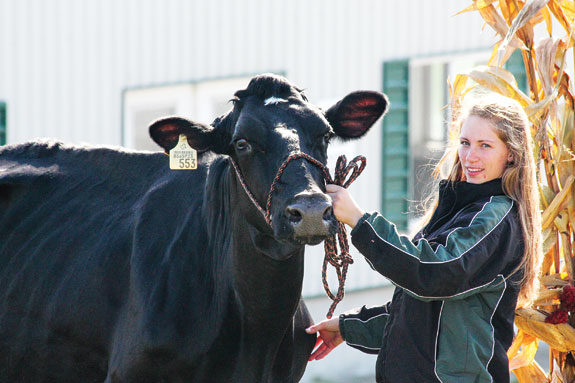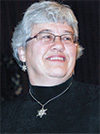Gerald and Dineen, and their children, Ashley and Jarrod, are the current operators of the dairy farm.
Jarrod is in process of completing high school, with plans for a future on the home farm.
Ashley, a 2012 graduate of the University of Guelph – Kemptville with an associate diploma in agri-food leadership, has already returned home and is now responsible for the herd breeding program. Her long-term plans are to form a partnership with her brother and parents.
The farm has 600 acres, all of which is devoted to providing for the needs of the dairy herd. They grow corn for use in silage or high-moisture feed, hay (both dry and as haylage), peas and oats. There is no pasture, except for a paddock for Ashley’s two horses. All crops are used by the farm.
With most of the feed grown at home, the Pulvers need to buy only the dairy supplement and minerals. They feed a TMR with different rations for different groups of cattle. Ashley has worked with a feed specialist to come up with the optimum ration.
Cows need a healthy rumen – the whole function of their entire being depends on it, she explains. Better nutrition has “done a lot for these cows,” she claims.
The farm has seen some recent updates. Last year, it added a composter to make bedding, as well as an addition to the dairy barn: a six-row freestall facility.
Ashley says cow comfort increased dramatically after the new addition to the barn due to the deep-bedded stalls, which allow more comfort and less stress. The barn has automatic temperature-sensitive curtains and large fans to help maintain comfort.
The dairy herd is all registered Holsteins, with 130 head of milkers and about 180 youngstock on hand. The milking herd is divided into three groups: 2-year-olds, who do better without competition from old bossy cows; a fresh group from calving to approximately 70 days to get them started; and a mainstream group.
Milking is done in a double-eight parlour, requiring about two hours of milking time for one operator.
Ashley is enthusiastic about her job as manager of the breeding program and uses a number of tools to help improve the herd. Her breeding goals include “breeding cows that are built to last,” an essential component of increasing longevity in the herd.
She would like to see a better balance of older and younger cows, noting the percentage of first-calf heifers is higher than what she would prefer. At this point only about six cows have completed six or more lactations.
A classifier visited the farm this spring and helped her learn what weaknesses in structure were of concern in the herd. Ashley will now be working to correct these issues by paying close attention to choosing mates for her cows with these in mind. Already, she has made culling decisions on heifers for rump structure and legs.
Her sire selection criteria are strict. She wants bulls balanced in production, type and health traits, with positive scores for fat and protein deviation. She also wants bulls to improve somatic cell score.
That’s a tall order. For herd recording, she uses a mating program that chooses the best mate for a cow within parameters she sets.
Ashley already has a very good pregnancy rate at 25 percent and a conception rate at 41 percent. These numbers are well above the national average rates, proving that Ashley is doing a good job.
Ashley works with sales representatives to make good breeding decisions. These guys see bull progeny on other farms, which gives them a bigger picture of a bull’s value than just looking at one herd.
Matings are planned early, and semen is purchased on a monthly basis and stored on-site. Ashley does the lion’s share of inseminating the cows, with her dad filling in as necessary.
She breeds twice per day, after milking in the morning and again in the afternoon. She follows the AM-PM rule: A cow seen standing in the morning is bred in the afternoon, and vice versa.
Ashley credits good observation skills for heat detection, as 48 percent of cows are bred following an observed heat. This, of course, depends on people being in the barn and paying attention to the cows. In addition, she uses pedometers on the rear legs of the cows. Activity information on each cow is read as they enter the parlour and sent to the computer.
CIDRs are used on problem cows so they come into heat the day of a herd health check. The veterinarian checks their fitness to breed, saving lost semen costs on cows unable to conceive.
Management is key to having high pregnancy and conception scores. Ashley says, “You feed them well, you care for them well, they’re gonna do it for you. Cows that are happy get pregnant.
“Everyone likes happy cows,” she adds. “Happy, healthy cows make happy, healthy farmers.”
In her limited spare time, Ashley enjoys the company of her boyfriend, Patrick, a full-time employee at the farm, and her horses and dogs.
Riding is important to her, and she participates regularly in team penning and ranch sorting with her quarterhorse mare, “Pony.” She also has a retired Appaloosa mare. Her dogs, a golden retriever and a king shepherd, are also important to her, traveling with her to many events.
She is not involved in any organizations at the moment, although she has been in 4-H and may return as a leader some day. She attends Progressive Dairy Operators events, including the symposium last March. PD
Alice Guthrie is a freelance writer from Hagersville, Ontario.
PHOTO
One year after completing university, Ashley Pulver has found her fit on the home farm, managing the herd’s breeding program. Photo courtesy of Ashley Pulver.








